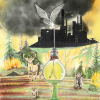
Student Spotlight: Mohammad Shafiq
In this 2020 interview with River of Words, Mohammad Shafiq speaks about his creative process, and the inspiration and imagery behind his winning art piece, “Let's Serve Them Than Being Disaster.”
Meet Mohammad:
Q: What is your current age?
Now I’m nineteen years old.
Q: Can you tell us a little bit about where you live and where you are from?
I live in a refugee camp in Quetta, Pakistan and I’m From Afghanistan.
Q: How did you get into making art?
I was doing good painting in school as at home. My parents encouraged me and they took me to an art class.
Q: What’s your process like? What do you usually use as a medium? How do you get ideas?
My process in art is realistic and imaginary. I usually use pencil, colored pencil, oil pastel and soft pastel. I get ideas from how I view something, observation, and my imagination.
Q: What do you enjoy the most about making art?
I think art is my language and my weapon. I use it to inform others about something and to defend the rights of issues I find important.
Q: Let’s talk about your piece “Let's Serve Them Than Being Disaster.” This piece has a lot of layers and meaning. Can you describe it to us and walk us through your process? Did you use any mediums other than color pencil? We thought you may have used fire to make the smoke.
This world is big and has so many creatures and we have been unfair to animals and nature. We built and discovered everything for ourselves, to make everything easy without having any respect for nature. Now we have the current situation of Global Warming. My artwork is meant to say that we have to care about nature and serve it. The light bulb means, we have to bring light to the dark environment and make it green. I used fire for the smoke and the rest is colored pencil.
Q: There are two images that carry the intensity of the piece: black smoke coming from a factory, and a light bulb hanging by a dove with a little plant growing inside. There's also fire and water. Where you intimidated by having so many elements be part of your creative vision? Where you excited by the challenge? What was your motivation to get so much work done?
I like to use different elements in my art, this idea took me a long time after searching and thinking a lot. The black smoke coming from the factory shows global warming, which causes the forest to burn and the white bird means peace upon those animals. The light bulb with a little plant growing inside shows the solution, which means there should be green as a light over dark. With these elements I was able to show these things. When I was searching and working on it, day by day it was becoming more exciting to me and I got motivated by this method of working which automatically challenged me to show it to others.
Q: How did you find out about River of Words?
About four years ago, I got information about River of Words from the internet on Facebook.
Q: What role has River of Words played in your life?
Honestly, River of Words made me think about the environment more deeply and gave me a purpose, a place to to share my art and a direction on what to create.
Q: A watershed could be a lake, a stream, a reservoir, a wetland, and groundwater. Here at River of Words we talk a lot about getting to know your local sources of water, about observing them and conserving them. What does the word watershed mean to you?
I think all of life's creatures are related to water. The duration of life and also the ecosystem. Also the foundation of a beautiful and healthy environment is water. Here, the people get water by themselves from groundwater.
Q: We call someone who explores their watershed and the environment they live in a Watershed Explorer. Do you consider yourself a watershed explorer? Why or why not?
Yes, anyone who lives in an environment, who loves nature, and who likes to share his/her opinion about it to others is a Watershed Explorer.
Q: What advice would you give to another young person about creating art?
I have seen many young artists who don’t know what to create. I suggest they look around more closely at their environment. If you are concerned about issues against cruelty, violence against women and more, you can create art about these things.
Q: What is your advice for a young person who wants to be more involved in taking care of their environment and who wants to get to know their local watershed?
Where I live there is no caring about the environment. Please avoid cutting and burning the trees. Accumulate knowledge about nature and the ecosystem. Be a part of those who love and appreciate nature.